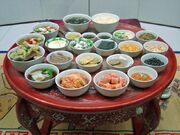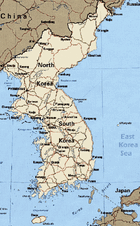Browse All Korean Recipes: Korean Appetizers | Korean Beverages | Korean Soups | Korean Salads | Korean Vegetarian | Korean Meat Dishes | Korean Snacks | Korean Desserts

|
This article is a stub! This article doesn't contain enough information. If you know anything about Korean Cuisine, please add to this article!
|
Overview of Korean Cuisine History
Korean cuisine is exotic and rich in seasonings and spices – Onion, ginger, red pepper, soy sauce, bean paste, sesame, vinegar and wine. Some Korean dishes are preserved by fermenting (kimchi, bean paste, and soy bean sauce) or drying (salted fish). Kimchi, which is vegetables (usually cabbage pickled with red pepper and salt, is probably Korea’s most famous dish. Kimchi is served to complement almost every meal.
One of the more popular Korean dishes is bulgogi, or Korean barbecue. In this famous dish, meat is marinated in soy sauce, garlic, sesame oil, sugar and other seasonings, then grilled.
Korea is also known for its “soup culture”, which developed over the course of its history as a way to get through famines. Maeuntang is a spicy soup consisting of white fish, bean curd, vegetables and red pepper. Twoenjang-guk is soup made from fermented soybean paste.
Koreans have also developed a way to brew grains in order to make Korean wine. rice, Wheat, Barley, millet and beans are five such popular grains used for winemaking. Fruits, roots and petals of flowers are also used to make wine. In spring, Koreans like wine made from azalea petals. cherry wines, ginseng wines, apricot brandies and pine tree wines are also popular wines in Korea.
In general, the Korean diet is healthy and well balanced: it is high in fiber, low in fat, and has moderate caloric content. It consists mainly of grains (rice) and vegetables (bean curd and bean sprouts), then meat and seafood.
Rice is a staple in the Korean diet and is eaten with various side dishes and soup for the typical meal at home. Side dishes can be as simple as marinated vegetable salads and as complex as bean jellies with dressing. Traditionally, housewives prepared these "side" dishes from scratch almost daily - with the number and tastiness of the dishes reflecting the wife's culinary ability, as well as the ability to afford the variety.
The number of side dishes on the table was once an indication of one’s status in Korean society. Commoners had only 3 to 5 side dishes, while the rich had 12 or more. In modern times, the most popular side dishes can be purchased ready-made at the neighborhood grocer.

Hanjeongsik, a full-course Korean meal with a varied array of banchan
Aside from the individual bowl of rice and soup, and the shared side dishes or "ban-chan", a shared main dish will be served, usually consisting of a stew or casserole of seafood, meats or tofu, or broiled or dried fish.
A variety of seafood is popular and widely available. Many kinds of fish, crabs, oysters, shrimp, octopus and squid, and clams of all sorts are eaten daily. Beef and pork are also popular, while chicken and other poultry is usually relegated to specialty dishes.
Cuisines of Korea

Map of Korea - Click to enlarge
By Geographic Area and Style:
Korean Food Glossary
Finding the ingredients for a Korean Recipe is not so easy when you do not know the names of the ingredients. Take time to make a list of ingredients and the name they may be found under at the Local Markets.
- Check out the Korean Food Glossary
Add a Term to the Korean Food Glossary:
Korean Food Traditions and Festivals
Koreans celebrate 12 traditional holidays in the Lunar Calendar. The most important celebrations are SeolNal (Lunar New Year) and ChuSok, the Korean Thanksgiving. Another celebration is Buddha’s birthday, a the national holiday. The atmosphere of the holiday is punctuated by parades with lotus-shaped lanterns in the streets. All Koreans holidays are celebrated with the family, and both cooking and eating traditional meals is the most important activity during these celebrations.
Ttokkuk, or rice-cake soup, is the special dish eaten in Korea at birthdays and New Year. Ttok, or rice cake, is cut into round shapes, representing the circle and the strength of life.
Add Korean Recipes or Content
Template:Createkoreancontent
Korean Cuisine Related Recipes
- Category Korean
- Bulgogi
- Ggoma Kimbap
- Stuffed Cucumber Kimchi
- Instant kimchi
- Spicy Korean Kimchi
- Japchae
- Pajeon (Green Onion Pancake)
- Steamed Rice Cake with Mung Beans
- Persimmon punch ("sujunggwa")

